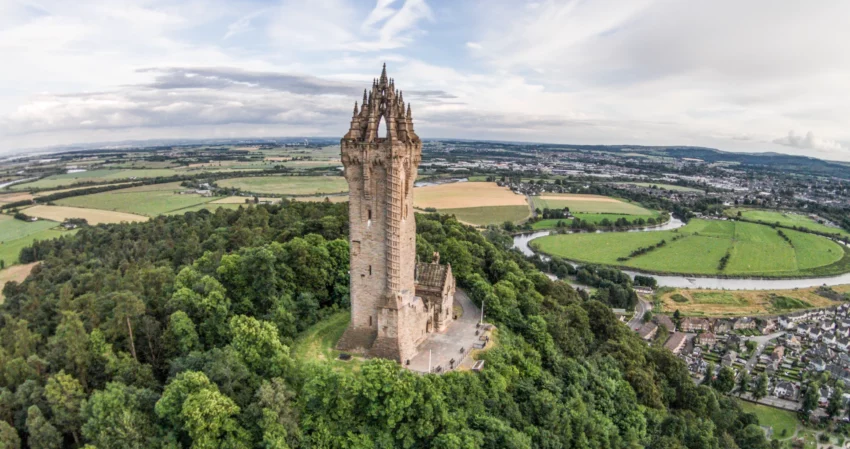Get your dose of History via Email
The Wallace Monument: Historical Context and Commemoration
The Wallace Monument, officially known as The National Wallace Monument, is a tower standing on the summit of Abbey Craig, a hilltop near Stirling in Scotland. It commemorates Sir William Wallace, a 13th-century Scottish hero. Wallace was a central figure during the Wars of Scottish Independence, renowned for his defeat of the English army at the Battle of Stirling Bridge in 1297 and for his leadership in resistance against English rule until his capture and execution in 1305.
Architectural Design and Construction
The monument, designed by the Scottish architect John Thomas Rochead in the Victorian Gothic style, stands at 67 meters (220 feet) tall. Its design is a harmonious blend of architectural elements that conjure medieval fortifications and towers. It’s said that the structure was inspired by the Scott Monument in Edinburgh, but displays a more strikingly militaristic and nationalist character.
The decision to build the monument was taken in the 19th century when there was a resurgence of interest in Scottish history and national identity, partly spurred by the literary works of Sir Walter Scott. A competition for the design of the monument was held, and Rochead’s work was chosen among several entries. Funded through a campaign of public fundraising alongside donations by several European nobles and even the Italian national hero Giuseppe Garibaldi, the foundation stone was laid on 24 June 1861, with the monument being completed in 1869.
Symbolism and Galleries
The tower of the Wallace Monument is not only a memorial but also a symbol of Scottish national pride. Each of the monument’s four floors contains exhibits and displays related to Wallace and the Scottish Wars of Independence. Visitors can ascend the spiral staircase to reach the Crown, which offers panoramic views of the Scottish countryside and, on a clear day, a sight of Ben Lomond, a prominent mountain in the Highlands. Among the highlights within the monument’s galleries is the Wallace Sword, which is said to have belonged to Sir William Wallace himself.
The Legacy and Modern Relevance
The Wallace Monument has stood for over 150 years as a testament to Scottish nationalism and remains an important tourist destination and symbol of national pride. It also has a substantial cultural meaning, as Wallace became part of the mythic history of Scotland, further popularized by the film ‘Braveheart’ in the 1990s. Visitors are encouraged to understand the life and times of William Wallace and his role in Scotland’s struggle for independence. The recognition of Wallace’s sacrifice and his elevation as a national hero are central themes celebrated by the monument.
Operations and Accessibility
Managed by an independent charitable organization, the Stirling District Tourism, the Wallace Monument is open to the public, providing educational programs and various events throughout the year. The surrounding grounds are typically open all year, offering an opportunity to appreciate the impressive appearance of the monument against the natural landscape. The edifice is also renowned for being accessible by a shuttle bus service from the car park at the base of the hill, although some prefer the walk up Abbey Craig for a more immersive experience.
Commemorative Events
The Wallace Monument has served as a focal point for commemorative events throughout its history, with wreaths often laid at its base. The monument also became a rallying point for political acts and demonstrations, particularly during the late 20th century as debates around Scottish independence gained momentum. Such events underscore the potent role the monument plays in the country’s ongoing dialogue on sovereignty and national memory.
Conclusion
As a steward of Scottish cultural heritage, The National Wallace Monument stands not only as a historical commemorative structure but also as a living repository of a nation’s legacy. It continues to inspire those who visit and serves as an anchor in Scotland’s historical narrative, acknowledging the past while illuminating contemporary Scottish identity.
Sources:

